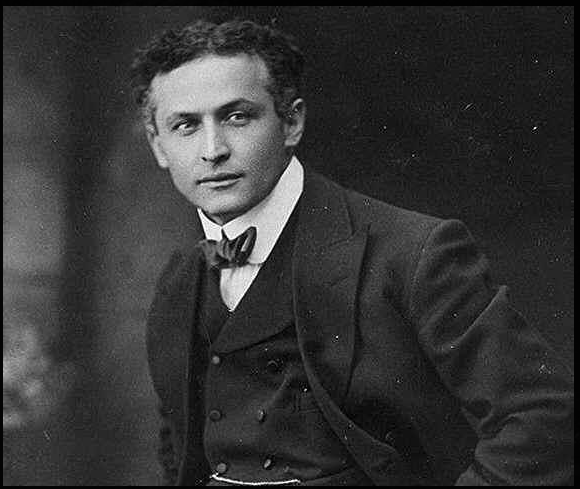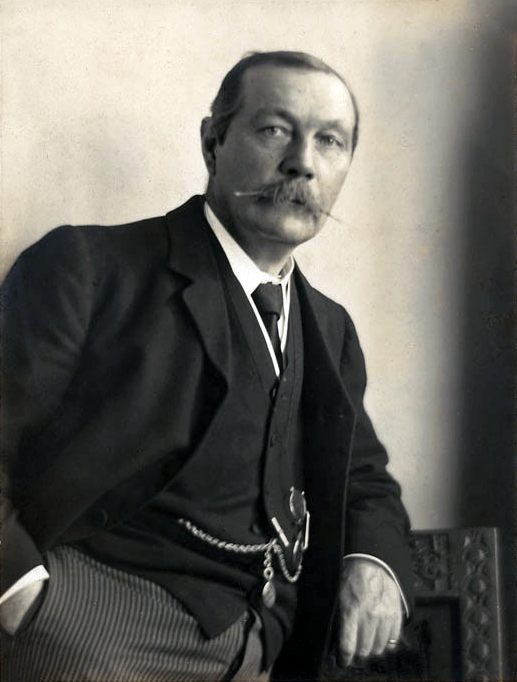By Tom Sheeter
Harry Houdini left us on October 31, 1926.

Or perhaps his spirit lingers on, as his former friend Sir Arthur Conan Doyle believed.
Even more unlikely than the mutual admiration shared by the showman and the scribe was a source of its undoing: disputed photographs and a mocking selfie.
The two celebs met in 1920 when Houdini toured Europe. That year in The Strand magazine, Conan Doyle declared the authenticity of the Cottingley “fairy photos” taken by two young cousins from Yorkshire. (Perhaps these shots were a harbinger of future selfies and fake news?)
These five photos would come back to haunt Conan Doyle – and not in the way he might have expected.
Spiritualism seems an odd enthusiasm for the creator of the uber-rational Sherlock Holmes, but Conan Doyle embraced the idea of life after death when he lost his son in World War I. Houdini had a long-standing interest in spiritualism, intensified by the loss of his beloved mother. The two seekers came to dramatically different conclusions about the afterlife.
Conan Doyle was a vocal champion of spiritualism, published extensively on the subject, and donated millions to the cause. His second wife, Jean, was a self-professed medium. She also practiced automatic writing. (Easy to see how that might appeal to the most in-demand writer of his day.)

Houdini embarked on an equally high-profile campaign to debunk purveyors of séances, ectoplasm, hoodoo, and what he saw as cruel trickery aimed at vulnerable and gullible participants. Doyle initially supported these exposés because he felt his friend was driving fakes out of business.
If Houdini had simply announced his disbelief in mysticism in general and fairies in particular, the friendship might have survived. However, Harry Houdini had a “go big or go home” mindset and added a visual bitch-slap to his argument. He produced a “spirit selfie” of himself conferring with the ghost of Abraham Lincoln. He also explained the basics of double-exposure to the public. The Harry-meets-Abe photo is now in the Library of Congress.
Houdini was not the only critic to declare the Cottingley photos a hoax. British photographer and physician Major John-Hall Edwards was particularly scathing. He wrote that embracing absurd beliefs in the supernatural would endanger the mental health of the next generation.
Houdini and Conan Doyle struggled to look past their differences, but the rift between them went seismic after Houdini rejected the authenticity of Lady Conan Doyle’s powers. (She conducted a séance in which she claimed to contact Houdini’s mother, a native of Hungary, whose English improved remarkably after her death.)
The two men stopped speaking to each other and Lady Conan Doyle issued a prophecy (or threat, depending on your point of view): “Harry Houdini is doomed….” Another medium/protégé in her inner circle supposedly put a curse on him. (However, this claim might be part of Houdini’s PR, another area of his expertise.)
Houdini died in Detroit from complications following a ruptured appendix. He was 52. ConanDoyle outlived him by four years. He died in his home in East Sussex at 71.
There is some evidence that the men did not take their enmity to the grave (or beyond). Houdini’s widow sent Conan Doyle her husband’s collection of books on spiritualism. He accepted the gift after she assured the writer of her husband’s genuine affection and esteem.
In the 1980s, one of the Cottingley cousins confessed that they staged the photos with cardboard cutouts of fairies found in books. The father of one of the girls was an avid photographer, and they had access to his camera and his darkroom.
The 1917 photographs and one of the cameras used to take them are part of the permanent collection of England’s National Science and Media Museum. The camera is a Midg No. 1 quarter-plate model, manufactured by W. Butcher & Son, London, 1902-1920. It is made of mahogany and contains a drop-plate magazine. It features a focusing Beck Symmetrical lens and an everset shutter. It can hold 12 plates or 24 film sheets in quarter-plate size.
The glass photographic plates of the Cottingley Fairy Photos belong to an anonymous collector who purchased them at a London auction in 2001 for about $9000.

Tom Sheeter is a Los Angeles based writer and Sr. Account Manager at Superstock. He specializes in film and tv licensing and clearance issues.
(tomsheeter@bellsouth.net)

Comments
Enlightening and beautifully written.
How interesting. Loved the story